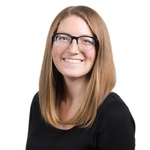In This City, Residents Can Search And Apply for Affordable Housing Online

The San Francisco–Oakland Bay Bridge TierneyMJ/Shutterstock.com
San Francisco took a laborious paper process and transformed it into an easy-to-use online application system for open affordable housing spots.
San Francisco has a well-documented housing problem, driven by a growing population, stark income inequality, and skyrocketing housing prices. The crisis has led to a striking definition of low income households—to qualify for a two-bedroom affordable housing unit in 2017, the income threshold ranged as high as $83,000—and a mad scramble for housing, even among the wealthy (a condemned house in nearby Fremont last year sold for $1.23 million).
When even those who reap the most from the Bay Area’s thriving tech and finance economy have to dig that deep for housing, the prospects for those seeking affordable rentals can seem grim. As of 2018, San Francisco had around 33,000 affordable housing units, making up about 9% of the city’s housing stock. But that number is growing, as 32% of new units built in the city in 2017 were affordable, part of the city’s plan to add 10,000 new affordable housing units to the market between 2015 and 2020.
In addition to adding new units, the city is also trying to make it easier to find and apply for available ones. As part of this effort, they created the Database of Affordable Housing Listing, Information, and Applications, or DAHLIA for short (the dahlia also happens to be San Francisco’s official flower).
DAHLIA, which debuted its first pilot in 2016, is a sleek, one-stop shop, and a dramatic transformation from what the process of applying for housing used to look like, said Maria Benjamin, the deputy director of the Mayor’s Office of Housing and Community Development. The application process is just for privately owned units, as public housing isn’t included.
The process used to be done all on paper. Developers would advertise their units with a flyer or a newspaper ad. Housing seekers had to visit the developer to get an application, then fill it out, and attach all the qualifying income documentation, including tax returns, pay stubs, and bank statements, and finally travel back to the developer to submit it. Developers would hire temporary staff to enter huge numbers of applications into a system, and the error rate was high, Benjamin said.
“You’d see lines around the block to turn in applications on the last day,” Benjamin said. “And the closer it got to 5 p.m., the more people panicked. It was ugly.”
Benjamin said the old process was particularly hard on seniors and people with disabilities. Some developers only accepted applications during business hours, and each had different requirements. And all that work didn’t even guarantee housing—it amounted in a small numbered paper lottery ticket, like the ones that come out of arcade games.
“So many people just threw up their hands and said, ‘This is too hard,’” Benjamin said.
Tasked with fixing a broken system by former Mayor Ed Lee, the MOHCD applied to a program called Civic Bridge, run out of the city’s Office of Civic Innovation. Through the program, government departments get 16 weeks of free help from companies that partner with the city to solve problems. Krista Canellakis, the Chief Innovation Officer of San Francisco, said that the city is fortunate to “have a backyard filled with companies who want to give back.”
But before Canellakis’ team assigns a company to a project, they have to make sure that the department is ready for changes that might be painful. “Often times we’re asking departments to go outside the box, and leadership needs to be on board to take on new approaches,” she said. “After the company is gone, it’s up to the department to drive the project forward, so they have to be ready for that.”
In the first round of Civic Bridge projects, MOHCD was assigned Google as their corporate partner, which would dedicate 20% of some employees time to the project.
“I was skeptical of the whole Googler thing at first,” said Benjamin. “I thought they would come in and tell us how to do our work. But I was also desperate. We had tried to do this on our own and couldn’t find a vendor to build it for us.”
Although Google’s staff didn’t end up building DAHLIA in the 16-week timeframe, they helped MOHCD scope out all their needs, and worked with them to design a program that was as user-friendly as possible. The system debuted in a skeleton form with apartment listings and counselor resources in February 2016. So far, it has cost about $4 million.
Canellakis said that DAHLIA has gone on an interesting trajectory unlike any city project. “It’s an interesting model to use pro bono help to shape the problem statement, have a vendor build it, to now, where MOHCD gets in-house design help from the city’s digital services team, which didn’t exist when DAHLIA was launched,” she said.
DAHLIA has received 2.8 million visits since it launched, and processed 300,000 applications. The application has been simplified and standardized across developers, and income documentation now can be submitted after a person has been selected by the lottery.
The city still offers paper forms, which have been simplified and streamlined, but 97% of applications now run through DAHLIA. The city has also worked to make the online system more accessible, investing in nonprofits who will walk people through the online application process, provide language help, and set up email accounts for people who need them to apply.
While the new system doesn’t get people housed faster, it does make the process easier, Benjamin said. Most of the lag time happens after the lottery, when leasing agents review all the application materials and compliance officers approve income calculations.
Benjamin said the clearest difference can be seen with the lotteries themselves. Before, they would pull the paper lottery tickets from a bowl one at a time, and MOHCD had to rent out huge spaces to accommodate all the people who came to see if their number was called. In a lottery before DAHLIA debuted, there were 1,700 applications for 52 units, and many of those people showed up in person.
“Now, if we have five people at a lottery, that’s a lot,” Benjamin said. Lotteries that used to take hours now take 30 minutes. The lottery is run through Salesforce, and applicants are automatically notified of their status through their DAHLIA accounts.
The ease of the system has led to more applicants, which has made the process more competitive. But Benjamin said that’s a good thing, because it is pushing the city to fulfill affordable housing goals.
People from neighboring cities have also started applying, and since San Francisco made their tool open source, other cities in the region have reached out for help in building their own affordable housing tools.
But Canellakis said that the model used for DAHLIA doesn’t have to be limited to Silicon Valley. “Every city has a private sector, maybe not with this concentration of tech companies, but I’d encourage other cities to investigate what their local private sector can bring to the table,” she said. “Academia can be a partner, or architecture firms, or healthcare companies, or finance organizations. There are a lot of possibilities.”
And perhaps the best benefit of this partnership, according to both Canellakis and Benjamin, is the potential for city departments to learn skills and apply them on their own to new challenges. Benjamin said that user-centered design is now “standard practice” for MOHCD, and Canellakis called that attitude a “lighthouse for other city departments.”
“Sometimes, we think government can’t be as good as the private sector, but that’s just false,” Canellakis said. “DAHLIA shows that we can achieve things that no one thought government would be capable of in the past.”



